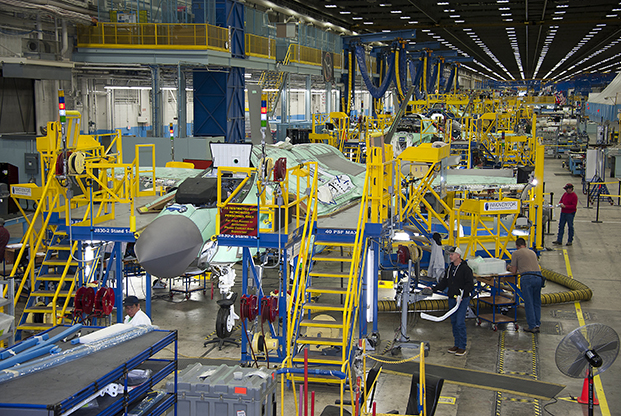
Lockheed Martin’s F-35 line in Fort Worth, Texas, is the largest military aircraft production facility in the world. It is frequently updated to incorporate more efficient materials and processes. Randy Crites/Lockheed Martin??????
Acknowledging that the F-35’s sustainment cost is too high, Joint Program Executive Vice Adm. Mat Winter said Wednesday his organization is taking immediate steps to get the program on a more affordable vector, although he didn’t forecast how quickly these efforts might pay off.
The JPO is conducting a “deep dive” to better understand Lockheed Martin’s production costs in order to find savings on touch labor, he said.
If current sustainment costs remain unchanged “into the future, as our fleet grows from the 280 aircraft [today] to the 800-plus that we’ll have by the end of 2021, we will be unaffordable, in that the services’ budgets will not be able to sustain that,” Winter told reporters at a press conference in Arlington, Va.
Winter said he expects the F-35 to enter full-up Initial Operational Test and Evaluation in September—some four months later than the JPO’s last estimate—and wrap up in May 2019. “Pre-IOT&E” events were undertaken with the Director of Operational Test and Evaluation’s blessing: cold-weather testing at Eielson AFB, Alaska, and evaluation for close air support along with other ground-support missions. These tests are set to get underway in March or April.
The bad sustainment actors in the F-35 fleets are in the early production lot aircraft, Winter explained. Lot 2 through 4 aircraft are available about 40-50 percent of the time, he said, while later jets from Lots 9 and 10 are turning in availability rates of 70-75 percent. The overall fleet average is about 51 percent. It makes sense that the earlier jets performing more poorly because they were built from an immature design and now have “seven to eight years of wear and tear,” he said. With the benefit of operational experience and revised design, later jets are better-functioning and more easily sustained, he said, and spare parts production is more robust.
Two things are being done now to get availability rates up. First, Winter said, the services are organically “increasing repair capacity” for spare parts because they have stood up their own depots. This frees up vendors to concentrate on making parts for production and spares on newer aircraft. The depots are taking over repairs on tires and wheels, avionics, canopies, etc., leaving vendors more breathing room for manufacture of new items rather than replacements.
“Fiscal Year ’18 is the transition year to start that up,” Winter said.
Second, a push is on to get better performance from test equipment to reduce false positives, he said. Too often, parts are being pulled and sent for repair because the local test gear says they’ve gone bad, but in fact, there’s nothing wrong with them, and they get “RTO’d,” he said, meaning “Return – Test Okay.” The newest version of the Autonomic Logistics Information System should cut down on false positives, Winter said.
“So, we are putting all these initiatives in place, we are reviewing that data back to the services so they can make good, informed decisions about the path forward on sustainability, production and capabilities,” he added.
As to the overall price of the F-35, Winter said “I am not satisfied that the cost is coming down fast enough,” and so the JPO is doing a “deep dive,” in partnership with Lockheed Martin, to assess why touch labor costs aren’t going down more rapidly. They are looking “everything from bathroom breaks to how long the paperwork takes” to scrap, repair and rework events to see where there may be bottlenecks. This is also being done with the top 100 suppliers, he said, toward obtaining a fine “granularity” of cost understanding. This in turn will be applied to negotiating the Lot 11 contract, which Winter expects will yield yet another unit cost price drop. Negotiations on Lot 11 started about 18 months ago, and although Winter previously said he hoped for a signed deal by the end of 2017, it has taken a while for the new Pentagon leadership to get fully up to speed on the program, he noted.
Lockheed Martin “could be more cooperative” on the negotiations, he said. “They could be more collaborative … they choose not to. It’s a negotiating tactic.” It’s far too early to think about imposing a “unilateral” deal, as happened on Lot 10, Winter said. That was and is “a last resort,” he added.
Asked if President Trump should “get involved” in the F-35 negotiations, Winter said the civilian Pentagon leadership is kept fully updated on progress, and “how they choose to use that information is at their discretion.”